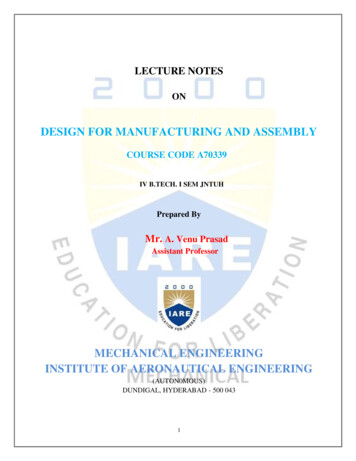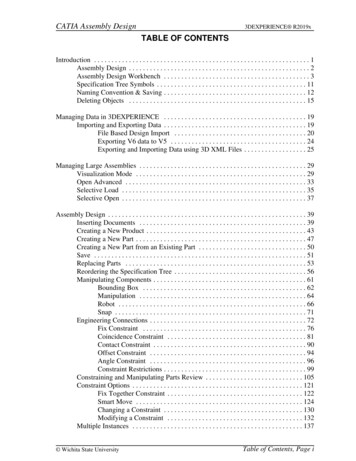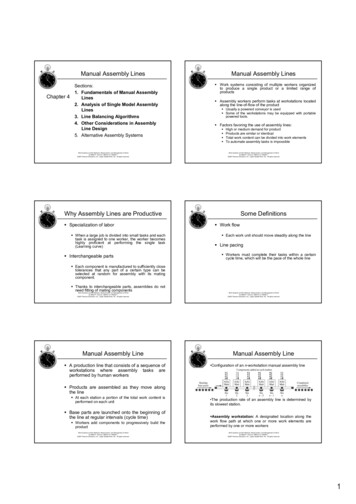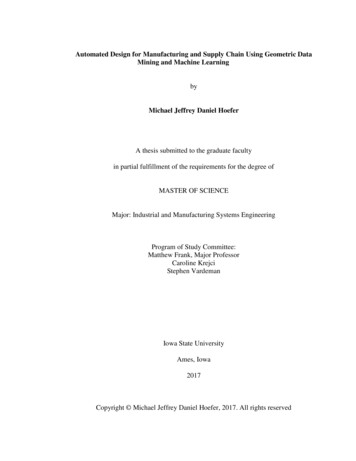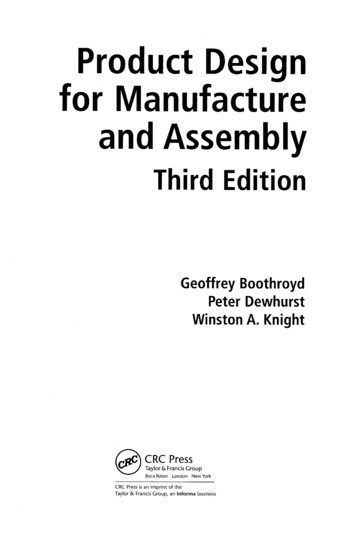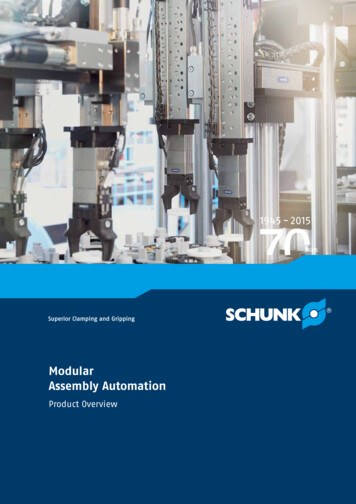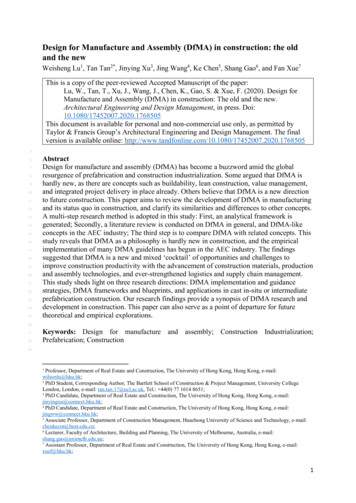
Transcription
Design for Manufacture and Assembly (DfMA) in construction: the oldand the newWeisheng Lu1, Tan Tan2*, Jinying Xu3, Jing Wang4, Ke Chen5, Shang Gao6, and Fan Xue7This is a copy of the peer-reviewed Accepted Manuscript of the paper:Lu, W., Tan, T., Xu, J., Wang, J., Chen, K., Gao, S. & Xue, F. (2020). Design forManufacture and Assembly (DfMA) in construction: The old and the new.Architectural Engineering and Design Management, in press. Doi:10.1080/17452007.2020.1768505This document is available for personal and non-commercial use only, as permitted byTaylor & Francis Group’s Architectural Engineering and Design Management. The finalversion is available online: bstractDesign for manufacture and assembly (DfMA) has become a buzzword amid the globalresurgence of prefabrication and construction industrialization. Some argued that DfMA ishardly new, as there are concepts such as buildability, lean construction, value management,and integrated project delivery in place already. Others believe that DfMA is a new directionto future construction. This paper aims to review the development of DfMA in manufacturingand its status quo in construction, and clarify its similarities and differences to other concepts.A multi-step research method is adopted in this study: First, an analytical framework isgenerated; Secondly, a literature review is conducted on DfMA in general, and DfMA-likeconcepts in the AEC industry; The third step is to compare DfMA with related concepts. Thisstudy reveals that DfMA as a philosophy is hardly new in construction, and the empiricalimplementation of many DfMA guidelines has begun in the AEC industry. The findingssuggested that DfMA is a new and mixed ‘cocktail’ of opportunities and challenges toimprove construction productivity with the advancement of construction materials, productionand assembly technologies, and ever-strengthened logistics and supply chain management.This study sheds light on three research directions: DfMA implementation and guidancestrategies, DfMA frameworks and blueprints, and applications in cast in-situ or intermediateprefabrication construction. Our research findings provide a synopsis of DfMA research anddevelopment in construction. This paper can also serve as a point of departure for futuretheoretical and empirical explorations.Keywords: Design for manufacture and assembly; Construction Industrialization;Prefabrication; Construction29Professor, Department of Real Estate and Construction, The University of Hong Kong, Hong Kong, e-mail:wilsonlu@hku.hk;2PhD Student, Corresponding Author, The Bartlett School of Construction & Project Management, University CollegeLondon, London, e-mail: tan.tan.17@ucl.ac.uk, Tel.: 44(0) 77 1614 8651;3PhD Candidate, Department of Real Estate and Construction, The University of Hong Kong, Hong Kong, e-mail:jinyingxu@connect.hku.hk;4PhD Candidate, Department of Real Estate and Construction, The University of Hong Kong, Hong Kong, e-mail:jingww@connect.hku.hk;5Associate Professor, Department of Construction Management, Huazhong University of Science and Technology, e-mail:chenkecm@hust.edu.cn;6Lecturer, Faculty of Architecture, Building and Planning, The University of Melbourne, Australia, e-mail:shang.gao@unimelb.edu.au;7Assistant Professor, Department of Real Estate and Construction, The University of Hong Kong, Hong Kong, e-mail:xuef@hku.hk;11
5556575859606162636465666768697071727374757677781. INTRODUCTIONDesign for manufacture and assembly (DfMA) is an emerging approach in the globalarchitecture, engineering, and construction (AEC) landscape. In 2013, the Royal Institute ofBritish Architects (RIBA) published a Plan of Work for DfMA implementation. In 2016,Singapore’s Building and Construction Authority (BCA) issued an official guide facilitatingDfMA and its incorporation with Building Information Modeling (BIM). In 2018, the UKgovernment’s Infrastructure and Projects Authority published a revised National Infrastructureand Construction Pipeline detailing its preference for the Platform Method for Manufacturingand Assembly Design. The report also publicized its use for prefabrication and other offsiteconstruction methods in public projects. The Hong Kong government’s 2018 documentConstruction 2.0 also emphasises the importance of DfMA. In the research realm, the DfMAliterature is growing, while industry leaders such as O’Rourke (2013) and Balfour Beatty (2018)consider DfMA to be the future of construction.But is DfMA merely old wine in a new bottle? According to Boothroyd (2005), DfMAevaluates and improves product design by considering the downstream processes ofmanufacturing and assembly. Similar if not identical concepts have been introduced to improveAEC productivity and efficiency. For example, buildability assesses designs from theperspective of those who will manufacture and install components and carry out theconstruction work (Lam and Wong, 2009); lean construction adapts the concept of leanproduction/manufacturing to the AEC industry with a view to maximising value andminimizing waste (Koskela, 1992; Alarcón, 1997). Value management (VM) focuses on theearly design stage and advocates achieving value for money by deliberating over functions andcosts (Kelly et al., 2004; Shen and Liu, 2004), with downstream manufacturing and assemblywithin the critical scope of the exercise.This paper aims to clarify the concept of DfMA in the AEC industry. First, we reviewthe literature on its history in the manufacturing industry and current DfMA developments inconstruction. The research then goes on to compare DfMA with the concepts mentioned aboveto find their similarities and differences. Based on the review and comparisons, this studyfurther provides prospects and challenges for DfMA. The remainder of the paper is organizedas follows. Section 2 is a detailed description of the research methodology. Section 3 is an indepth analysis of the DfMA research, while Section 4 compares DfMA with similar conceptswith a view to answering the key question of this study. Section 5 articulates the prospects andchallenges of DfMA, while conclusions are presented in Section 6.2. METHODOLOGYA multi-step research method consisting of brainstorming, literature review and in-depthcomparative analyses is adopted in this study. First, given the long history of DfMAdevelopment, an analytical framework is required to demarcate a reasonable research boundaryand guide the analyses. Since DfMA has only recently been popularized in construction, thisresearch includes DfMA-like construction concepts (e.g., fabrication-aware design) to allow itto be fully investigated. Brainstorming, as a creative training method, can find a set of practicalsolutions through objective and continuous analysis of the issues discussed (Rawlinson, 2017).To establish the analytical framework for this study, an hour-long brainstorming session washeld. Six researchers from different disciplines participated, all with at least six years’ researchexperience in the AEC industry and two with around 10 years’ experience in engaging withconstruction prefabrication in China and Hong Kong. Taking into account the possible bias ofbrainstorming, this step is only used to determine the scope of the discussion without having aconclusive effect on the outcome of the discussion. As a result of the session, the scope of thestudy was limited to seven broad DfMA-related categories: origins, definition, processes,2
7980guidelines, comparisons, prospects, and challenges. The analytic framework developed isshown in Figure 03104105106107108109110111112113114115116Figure 1 DfMA in construction: an analytic frameworkSecond, guided by this framework, a search was conducted for the relevant literature onDfMA in general, as well as DfMA-like concepts in the AEC industry specifically, using thebibliographic database Google Scholar. Keywords used in article selection included ‘design formanufacture and assembly’, ‘design for manufacture’, ‘design for assembly’, ‘DfMA’,‘fabrication-aware design’, ‘architectural geometry’, ‘architectural design’, ‘construction’,‘assembly’, ‘construction industry’, and ‘AEC’. These keywords were adopted to reflect usagesacross research disciplines and countries. For example, architecture researchers prefer‘fabrication’, while in engineering ‘manufacture’ is used to describe the building productionprocess. Mathematicians try to use architectural geometry to bridge the gap between complexarchitectural design and applicable construction. Year of publication was limited to the period2009 to 2019 to capture the latest DfMA research and trends in AEC. A total of 1979 resultswere generated from the initial search. Then, the strict filtered process was conducted to narrowdown the scope of target articles. Articles that included related key terms in thetitle/summary/keyword were considered for review, and only journal articles were selected toensure that all retrieved articles could be analyzed by using the same analytical structure as theirresearch objectives and methods. A snowball technique (Lecy and Beatty, 2012) involvingchecking the references of the selected papers was applied to find relevant papers that may nothave been included. Finally, 30 publications highly related to the DfMA in the constructionwere derived for the analysis of DfMA definition and research trend.The third step was to develop an in-depth understanding of DfMA by comparing it withsimilar concepts, such as buildability, value management, lean construction andprefabrication/Modular integrated Construction (MiC). The literature on these concepts wasextracted and reviewed for the comparative study which mainly focused on the connotations,extensions, and applications of the concepts and DfMA and analyzed their similarities,differences, and linkages. These comparisons were triangulated with the past experience of theauthors involved in BIM and offsite construction in Hong Kong, China, and the UK.3. DFMA: HISTORICAL DEVELOPMENT AND STATUS QUO3.1 Historical development of DfMADfMA originated during World War II when Ford and Chrysler applied it as a principle in theirweapon production processes. At first, it was used in manufacturing industry. Formalapproaches to design for manufacture (DfM) and design for assembly (DfA) emerged in the3
3134135136137138139140141142143144145146147late 1960s and early 1970s, reflected in UK standards published in 1975 on the management ofdesign for economic production. The academic exploration of DfMA also began in the 1970swith the practice and research of Boothroyd and Dewhurst. Since then, there has been muchdevelopment of DfMA within the manufacturing industry.According to Boothroyd (2005), DfMA provides a methodology for evaluating andimproving product design by considering the downstream processes of manufacturing andassembly. It thereby signifies a shift from traditional, sequential design thinking to a non-linearmethodology. The implementation of DfA and DfM has the potential to bring considerablebenefits, including reducing assembly and manufacturing costs, improving quality, andshortening production time by simplifying products. But these are only considerations ofproduction efficiency. Due to the requirements of sustainability, some scholars have begun toconsider the consideration of disassembly and recycling during the design phase. Researchersare beginning to focus on the design of the environment, recyclability, life cycle, etc. Thesestudies are sometimes referred to as Design for excellence (DfX) (Kuo et al., 2001). DfX is arelated methodology, where the ‘X’ refers to excellence in aspects including testability,compliance, reliability, manufacturability, inspection (DfI), variability (DfV), and cost (DfC).DfX in general aims to provide a standard philosophy, methodologies, and tools to optimize adesign (Gatenby and Foo, 1990; Kuo et al., 2001; Eastman, 2012). For example, DfX techniquescan improve quality, efficiency, productivity and design flexibility, and decrease life-cyclecosts using concurrent design concepts (Maskell 1991). DfX research emphasizes theconsideration of all design goals and related constraints in the early design stage (Kuo et al.,2001). Huang (2012) describes two streams of ‘X’, one with emphasis on a particular businessprocess and the other on a performance metric. DfA falls into the former since it focuses on theassembly process while using multiple performance measures (inspectability, compatibility,recyclability, serviceability, etc.). Design for modularity, on the other hand, is an example ofthe latter since it looks into modularity across several business processes from manufacturingto assembly, installation, distribution, and operation. DfMA falls into the business processstream, while both the manufacturing and the assembly processes serve as focal issues. Sincethe late 1990s, hundreds of papers have been published on the application of DfX inmanufacturing. However, this phenomenon has not happened in the construction industry. Thismakes it difficult to find all the information needed to apply DfX in the construction industry.1481491501511521531541551561571583.2 DfMA processes and guidelinesResearchers such as Swift and Brown (2013), Bogue (2012), and Emmatty and Sarmah (2012)have developed some guidelines for the application of DfMA, as shown in Table 1. It is asystematic procedure that helps companies make the fullest use of manufacturing and assemblyprocesses, e.g., through emphasizing the ease of manufacture and assembly by minimizing thenumber of parts (Kuo et al., 2001; Eastman, 2012; Bogue, 2012). DfMA aims to determine thecost impact of those materials and processes, and finds the most efficient use of the componentdesign (Ashley, 1995).Table 1. A non-exhaustive list of DfMA guidelines1234GuidelinesAim for mistake-proof designDesign for ease of fabricationDesign for simple partorientation and handlingDesign with predeterminedassembly techniques in mindBenefitsAvoid unnecessary re-work, improve quality, and reduce time andcosts.Reduce time and costs by eliminating complex fixtures and tooling.Reduce time and costs by avoiding non-value adding manual effort.Reduce time and costs when assembling.4
175176177178179180181182183184185186Consider modular designsReduce time and costs due to simplified design and assembly.Consider design forImprove assembly efficiency, quality and security.mechanized or automatedassembly7Use standard and off-the-shelf Reduce purchasing lead time and costs.components8Use as similar materials asReduce time with fewer manufacture processes and simplifiedpossiblejointing.9Use as environmentallyReduce harm to the environment.friendly materials as possible10 Minimize precast componentReduce time and costs with simplified design, manufacture, andtypesassembly.11 Minimize connector types and Reduce time and costs with simplified design, manufacture,quantityassembly, repair and maintenance.12 Minimize the use of fragileReduce costs due to fewer part failures, and easier handling andpartsassembly.13 Do not over-specify tolerances Reduce costs with easier manufacture.or surface finishSources: Swift and Brown (2013); Bogue (2012); and Emmatty and Sarmah (2012)However, current DfMA practices in construction still, by and large, follow DfMAguidelines developed in a manufacturing context without sufficiently considering thedifferences between construction and manufacturing. For example, DfMA procedures inBoothroyd (2005) consider DfA and DfM but not the downstream logistics and supply chain(LSC), which plays a critical role in offsite prefabrication construction. Some constructionDfMA guidelines proposed, e.g., Gbadamosi et al., (2019), Kim et al., (2016), and Banks et al.(2018), originate more or less from manufacturing-oriented guidelines. While inspiring, someof these guidelines are not necessarily a good fit with construction’s characteristics, leading toan inability to improve manufacturing and assembly. Some guidelines are proposed in afragmented fashion without necessarily forming an organic whole, leading to a lack ofcomprehensiveness, or “easy to use” throughout the building process. The RIBA, in recognizingthe potential of DfMA in construction, added an overlay of DfMA to its time-honored Plan ofWork. Following RIBA’s vision (2013, p. 24), much “soft-landing” work remains to implementDfMA in construction.Connecting general DfMA guidelines (Table 1) with the heterogeneities of the AECindustry to develop DfMA examples could inspire and encourage practitioners. Our stakeholderengagement with the industry has revealed that practitioners including clients, designers,contractors, and suppliers do explore such examples from the perspective of their separatecompanies. An industry-wide database of DfMA examples could increase its application.Another observation from the literature analysis and industry engagement is that we need todevelop DfMA strategies operable in terms of scope, policy, procedure, and so on at company,even industry, level. RIBA’s plan of work and various published DfMA blueprints are certainlymeaningful points of departure. To embrace DfMA, individual companies need to work withresearchers to devise such operable strategies. Frameworks and guidelines that can link generalguidelines with company-specific requirements are highly desired.1871881891901911923.3 Cross-sectoral learningWhen looking at the history of DfMA in construction, scholars often cite the pioneeringmodernist architect Le Corbusier who, in his influential book Towards a New Architecture(1923), advocated industrialization of construction and proposed the famous maxim, ‘A houseis a machine to live in.’ However, the popularity of DfMA in construction is a recent5
9210211212213214215216phenomenon. Unlike manufactured products which are designed in-house, mass-produced, andsold to end users, construction products (e.g., housing, buildings, and infrastructure) arebespoke (Fox et al., 2001). Every construction product is contextualized within the geotechnical conditions of the site and its surroundings, the planned socio-economic function, andmany other factors. There can be no ‘standard’, ‘one-size-fit-for-all’ design for mass production.It would be exceedingly difficult if not impossible for an architect, like his/her counterparts inmanufacturing, to conceptualize, optimize, prototype, and select a design to mass construct. Inaddition, the orthodoxy dislikes the tedium of ‘standard’ architecture design. Thus, the ‘oneoff’ project as an organization form has been adopted in the construction industry to organizeworks (Wang et al., 2018). Put simply, the construction industry looks at projects while otherindustries are concerned with products.While construction materializes our built environment and is linked to cultural identityand civic pride (Pearce, 2003), it has long been criticized for e.g., its nuisance, poor quality(Baloi and Price, 2003), and recently, alleged low productivity (The Economist, 2017). Crosssectoral learning has been exhorted for construction (Kao et al., 2009) but the authors of thispaper incline to attribute the learning to the industry’s self-introspection and humblecharacteristics. The construction industry has been reinventing itself through production theory(Koskela 1992), especially through integration of design, manufacture, and assembly(Bridgewater, 1993) and lean concepts and tools for making site assembly more efficient(Tommelein, 1998). In the 2010s, government and industry documents began to include DfMAin their development plans and to illustrate its detailed definition and application in the industry.In these plans, DfMA is advocated to combine architectural design, manufacturing and on-siteinstallation organically. The introduction of DfMA to construction industry can be understoodagainst this cross-sectoral learning and transformation 2302312322333.4 Status quo of DfMA in constructionThe Sankey diagram shown in Figure 2 illustrates some of the research trends relating to DfMAin construction drawn from the 30 selected articles. The width of the arrows is proportional tothe flow rate. The volume of this research has gradually increased over the past decade.Regarding research trends, architectural design journals tend to focus on the conceptual designstage, while engineering and construction journals focus more on the detailed design phase orthe entire project life cycle. There are more articles on DfM than DfA. This may be because alltypes of construction involve a manufacturing process. However, assembly problems oftenoccur in prefabricated buildings. In some architectural practices that do not fully adoptprefabrication, the idea of DfMA is nonetheless used. So although prefabrication, offsiteconstruction, and MiC provide ideal scenarios in which to explore DfMA (Yuan et al., 2018),its applications are not constrained to these areas. DfMA can be applied in traditional cast insitu construction. It can even be implemented as part of an on-site construction design or offsiteprefabricated design (Lu et al., 2018). The degree of implementation may be the entire building,an apartment, or just a component, reflecting the emphasis of DfMA on consideration ofdownstream processes in order to minimize costs and maximize overall value.6
234235236237238239240241242243244245246247Figure 2 Sankey diagram of DfMA research in the AEC industryA few empirical studies have begun to investigate the implementation of DfMA, mainlyin offsite prefabrication and modular construction projects. As summarized in Table 2, DfMAprinciples have been applied to various types of construction projects for various components.For example, Kim et al. (2016) reported the use of DfMA in the selection of suitable precastbeams for a highway bridge in the UK; Gerth et al. (2013) reported its application in detailingthe design of light walls for two four-story houses in Sweden. These studies reveal commonpractices in applying DfMA, such as identifying its driver, developing criteria for‘manufacturability’ and ‘assemblability’, investigating specific difficulties to address in design,involving different professionals in the design group, and optimizing design through variousprinciples.Table 2. A summary of construction projects applying DfMA principlesStudiesGerth et al. (2013)Project typefour-storey housesRelated componentslight wallKim et al. (2016)highway bridgeprecast beamChen and Lu ial andcommercial towernew solar towercurtain wall systemBanks et al. (2018)Peterseim et al.(2016)Ramaji et al. (2017)Machado et al.,(2016)student dormitorymodularized facade,MEP system,structure, etc.modules of cablestayed solar sandDfMA strategies detail the joint design minimize assembly operation minimize the number of parts simplify the operation choose material and components coordinate the design of LEDtubes and electric wires in thecurtain wall system coordinate the facade, MEPsystem, and structure select optimal components andmaterialsoptimize the size and geometry ofpartsimplement BIM as a catalyst for alean transformation, streamliningprocess and operations2487
82283284Previous studies have suggested different strategies for implementing DfMA, such asdetailed design, minimization/simplification, and design evaluation. Detailed design entailscareful planning to pre-empt issues in the manufacture and assembly stages through choice ofmaterials/components (Kim et al, 2016), integrating different disciplines in design, such ascoordinating the modular structure, façade, and mechanical, electrical and pumping (MEP)system in a high-rise building (Banks et al., 2018), or designing the LED tubing and electricwiring for a curtain wall system (Chen and Lu, 2018). Minimization/simplification emphasizesease of manufacture and assembly through minimizing the number of parts (Kim, et al., 2016),simplifying the geometry and reducing weights of parts (Ramaji, 2017), or decreasingcomplexity in operations (Gerth, 2013). These strategies can directly reduce cost, time, andwaste in both manufacture and assembly. In addition, evaluating engineering choices anddesign alternatives is also a main strategy of DfMA. Significant in this state of the art review isDfMA use for building façades (Montali et al., 2018; Montali et al., 2019; Giuda et al., 2019;Başarır and Altun, 2018), weatherproof seals (Orlowski et al., 2018), and modular components(Rausch et al., 2016). Few studies focus on design optimization of the whole built project,although some such as Yuan et al., (2018) have established a process information model forDfMA-oriented prefabricated buildings. Apart from these studies mentioned DfMA in theirresearch, some DfMA-like concepts were studied for the improvement of manufacturability andassemblability by focusing on the design stage. For example, many studies in architecture usefabrication-aware design to represent the same idea of DfMA. Pottmann (2009; 2010; 2013)proposed architectural geometry as a design fabrication-aware design knowledge to bridge thegap between design and construction. Tepavčević et al., (2017) established a fabrication-awaredesign method that can be easily manufactured and assembled. These DfMA-like concepts,including fabrication-aware design and architectural geometry, also enhance manufacturabilityand assemblability through the early architectural design stage.The construction industry has benefited from DfMA research and development in otherindustries. The automotive industry has explored reduction in number of parts in the assemblyprocess. With such reduction comes decline in associated assembly operations, saving parts andoperations costs (Boothroyd, 2012). When this strategy was applied in selected Swedishcompanies, half enjoyed up to a 33% reduction in development time and cost (Trygg, 1993). Inconstruction, the same logic is applied in MiC, reducing parts in prefabricated modules forassembly. Another commonly adopted DfMA strategy is to establish a concurrent engineeringenvironment. This encourages teamwork between designers, suppliers, manufacturingengineers, and any other relevant representatives in reviewing the current productmanufacturing and future product design to increase productivity and reduce lead time inbringing a new product to market (Boothroyd, 2012).2852862872882892902912922932942952962974. OVERLAPS BETWEEN DFMA AND OTHER CONCEPTS4.1 DfMA and BuildabilityThe concept of buildability can be traced back to the 1980s (Moore, 1996). It is defined byCIRIA (1983) as ‘the extent to which the design of a building facilitates ease of construction,subject to the overall requirements for the completed building.’ Buildability is measured on ascale from good to bad and is a criterion on which to judge the design of a building project(Wong et al., 2008. Bringing together the technical experience of builders and the designexperience of architects at the design stage, it reflects architects’ awareness of constructionmethod in the architectural design (Hyde, 1995; Wong et al., 2011). Buildable designs haveimproved quality and safety performance, as well as higher productivity levels, and mitigatethe risks of unforeseen problems (Lam and Wong, 2011). The achievement of good buildability8
4315depends upon both designers and builders being able to see the whole construction processthrough each other's eyes.In design for buildability, external factors such as geotechnical condition, access andcirculation at the site, and availability of resources, skills and technology, are firstly consideredto determine the most appropriate system to be used (Mbamali et al., 2005). Then, the principleof standardization, simplicity and integration or prefabrication are applied to achieve the desiredlevel of buildability (BCA, 2000; Wong and Lam, 2008). Table 3 presents some examplefeatures of these principles. Lam and Wong (2011) further summarize nine factors ofbuildability: (1) allowing economic use of contractor’s resources; (2) enabling designrequirements to be easily visualized and coordinated by site staff; (3) enabling contractors todevelop and adopt alternative construction details; (4) enabling contractors to overcomerestrictive site conditions; (5) enabling standardization and repetition; (6) enabling freedom ofchoice between prefabricated and onsite works; (7) enabling simplification of constructiondetails in case of non-repetitive elements; (8) minimizing the impact of adverse weather byenabling a more flexible construction program; and (9) allowing design to achieve a safeconstruction sequence on site.Table 3. Principles of buildability and their example 327328329330331332Example feature Repetition of grids, floor layouts, component sizes, etc.; Modularization of grids, concrete beams, slabs, etc.;Standardization Standardization of windows, doors, structural components, servicescores, etc. Flat floor slabs, pre-stressed concrete flat slabs;Simplicity Simple connection details; Simplicity in detailing. Precast components such as slabs, columns, beams, façade panels,Integration/Prefabricationwindow frames, staircases, etc.; Integrated roof system.Sources: Mbamali et al. (2005); Wong and Lam (2008)There are perceivable similarities and difference
Design for manufacture and assembly (DfMA) has become a buzzword amid the global . 8 . resurgence of prefabrication and construction industrialization. Some argued that DfMA is . 9 . . improving product design by considering downstream processes the manufacturing and of. 123 . assembly
